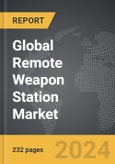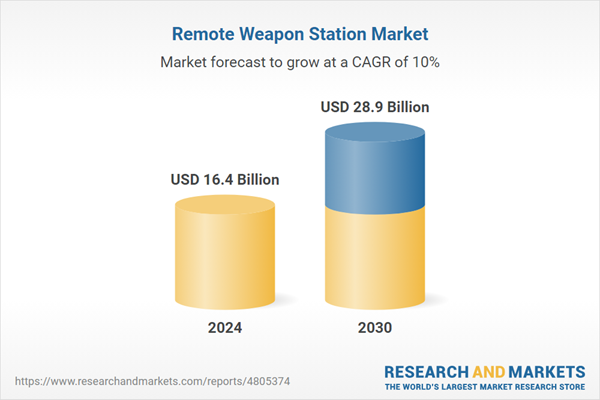Global Remote Weapon Station Market - Key Trends and Drivers Summarized
Remote Weapon Station: Redefining Modern Warfare
Remote Weapon Stations (RWS) have become an essential component in modern defense systems, offering a significant enhancement in the operational capabilities and safety of military forces. An RWS is a remotely operated weapon system that allows military personnel to control and fire weapons from a protected position, typically inside an armored vehicle or from a secure distance. This technology minimizes the exposure of soldiers to direct enemy fire, reducing the risk of casualties while maintaining effective firepower. RWS can be equipped with various types of weaponry, including machine guns, grenade launchers, and anti-tank missiles, making them versatile tools for different combat scenarios. The ability to operate in challenging environments, combined with the increased safety they provide, has made RWS a critical asset in modern military operations.What Technological Advancements Are Shaping Remote Weapon Stations?
Technological advancements are driving the evolution of Remote Weapon Stations, leading to more sophisticated, effective, and versatile systems. One of the key trends is the integration of advanced targeting systems, including high-resolution cameras, thermal imaging, and laser rangefinders, which enhance the accuracy and effectiveness of RWS in various combat conditions, including night operations and adverse weather. The development of automated targeting and tracking systems, powered by artificial intelligence, is also gaining traction, allowing RWS to autonomously identify, track, and engage targets with minimal human intervention. Additionally, advancements in communication and control systems are enabling more seamless integration of RWS with broader command and control networks, allowing for coordinated operations across multiple platforms. These technological innovations are enhancing the capabilities of RWS, making them more effective in modern warfare scenarios and expanding their use across different military applications.What Are the Key Applications and Benefits of Remote Weapon Stations?
Remote Weapon Stations are used in a variety of military applications, offering significant benefits that enhance combat effectiveness, safety, and operational flexibility. In armored vehicles, RWS allows soldiers to engage targets while remaining protected inside the vehicle, reducing the risk of exposure to enemy fire. RWS are also used in naval vessels, where they provide enhanced firepower and defensive capabilities against air and surface threats. In fixed installations, RWS can be deployed for perimeter defense, providing a robust and responsive security solution for critical military and civilian infrastructure. The primary benefits of RWS include improved soldier safety, increased accuracy and lethality, enhanced situational awareness, and the ability to engage multiple targets simultaneously. These advantages make RWS an indispensable component of modern defense systems, supporting a wide range of military operations in various environments.What Factors Are Driving the Growth in the Remote Weapon Station Market?
The growth in the Remote Weapon Station market is driven by several factors. The increasing demand for advanced military equipment that enhances soldier safety and operational effectiveness is a significant driver, as defense forces seek to modernize their arsenals with state-of-the-art technology. Technological advancements, particularly in targeting, automation, and communication systems, are also propelling market growth by enhancing the capabilities and versatility of RWS. The growing need for versatile and scalable defense solutions that can be deployed across different platforms, including land, sea, and air, is further boosting demand for RWS. Additionally, the rising focus on counter-terrorism and homeland security is contributing to market growth, as RWS provide a robust and effective tool for securing critical infrastructure and responding to emerging threats. These factors, combined with the continuous innovation in defense technology, are driving the sustained growth of the Remote Weapon Station market.Report Scope
The report analyzes the Remote Weapon Station market, presented in terms of market value (USD). The analysis covers the key segments and geographic regions outlined below.- Segments: Platform (Land, Airborne, Naval); Component (Weapons & Armaments, Human Machine Interface (HMI), Sensors); Weapon Type (Lethal, Non-Lethal); Application (Military, Homeland Security).
- Geographic Regions/Countries: World; United States; Canada; Japan; China; Europe (France; Germany; Italy; United Kingdom; and Rest of Europe); Asia-Pacific; Rest of World.
Key Insights:
- Market Growth: Understand the significant growth trajectory of the Airborne Platform segment, which is expected to reach US$8.3 Billion by 2030 with a CAGR of 9.5%. The Naval Platform segment is also set to grow at 9.1% CAGR over the analysis period.
- Regional Analysis: Gain insights into the U.S. market, valued at $4.5 Billion in 2024, and China, forecasted to grow at an impressive 9.3% CAGR to reach $4.4 Billion by 2030. Discover growth trends in other key regions, including Japan, Canada, Germany, and the Asia-Pacific.
Why You Should Buy This Report:
- Detailed Market Analysis: Access a thorough analysis of the Global Remote Weapon Station Market, covering all major geographic regions and market segments.
- Competitive Insights: Get an overview of the competitive landscape, including the market presence of major players across different geographies.
- Future Trends and Drivers: Understand the key trends and drivers shaping the future of the Global Remote Weapon Station Market.
- Actionable Insights: Benefit from actionable insights that can help you identify new revenue opportunities and make strategic business decisions.
Key Questions Answered:
- How is the Global Remote Weapon Station Market expected to evolve by 2030?
- What are the main drivers and restraints affecting the market?
- Which market segments will grow the most over the forecast period?
- How will market shares for different regions and segments change by 2030?
- Who are the leading players in the market, and what are their prospects?
Report Features:
- Comprehensive Market Data: Independent analysis of annual sales and market forecasts in US$ Million from 2024 to 2030.
- In-Depth Regional Analysis: Detailed insights into key markets, including the U.S., China, Japan, Canada, Europe, Asia-Pacific, Latin America, Middle East, and Africa.
- Company Profiles: Coverage of players such as Aselsan A.S., BAE Systems PLC, China North Industries Corporation (NORINCO), Elbit Systems Ltd., Electro Optic Systems Pty Ltd. and more.
- Complimentary Updates: Receive free report updates for one year to keep you informed of the latest market developments.
Some of the 14 companies featured in this Remote Weapon Station market report include:
- Aselsan A.S.
- BAE Systems PLC
- China North Industries Corporation (NORINCO)
- Elbit Systems Ltd.
- Electro Optic Systems Pty Ltd.
- Fn Herstal S.A.
- General Dynamics Corporation
- Imi Systems Ltd.
- Kongsberg Gruppen ASA
- Leonardo SpA
- Moog, Inc.
- Rafael Advanced Defense Systems Ltd.
- Raytheon Company
- Rheinmetall AG
- SAAB AB
- ST Engineering
This edition integrates the latest global trade and economic shifts into comprehensive market analysis. Key updates include:
- Tariff and Trade Impact: Insights into global tariff negotiations across 180+ countries, with analysis of supply chain turbulence, sourcing disruptions, and geographic realignment. Special focus on 2025 as a pivotal year for trade tensions, including updated perspectives on the Trump-era tariffs.
- Adjusted Forecasts and Analytics: Revised global and regional market forecasts through 2030, incorporating tariff effects, economic uncertainty, and structural changes in globalization. Includes historical analysis from 2015 to 2023.
- Strategic Market Dynamics: Evaluation of revised market prospects, regional outlooks, and key economic indicators such as population and urbanization trends.
- Innovation & Technology Trends: Latest developments in product and process innovation, emerging technologies, and key industry drivers shaping the competitive landscape.
- Competitive Intelligence: Updated global market share estimates for 2025, competitive positioning of major players (Strong/Active/Niche/Trivial), and refined focus on leading global brands and core players.
- Expert Insight & Commentary: Strategic analysis from economists, trade experts, and domain specialists to contextualize market shifts and identify emerging opportunities.
Table of Contents
Companies Mentioned (Partial List)
A selection of companies mentioned in this report includes, but is not limited to:
- Aselsan A.S.
- BAE Systems PLC
- China North Industries Corporation (NORINCO)
- Elbit Systems Ltd.
- Electro Optic Systems Pty Ltd.
- Fn Herstal S.A.
- General Dynamics Corporation
- Imi Systems Ltd.
- Kongsberg Gruppen ASA
- Leonardo SpA
- Moog, Inc.
- Rafael Advanced Defense Systems Ltd.
- Raytheon Company
- Rheinmetall AG
- SAAB AB
- ST Engineering
Table Information
| Report Attribute | Details |
|---|---|
| No. of Pages | 232 |
| Published | December 2025 |
| Forecast Period | 2024 - 2030 |
| Estimated Market Value ( USD | $ 16.4 Billion |
| Forecasted Market Value ( USD | $ 28.9 Billion |
| Compound Annual Growth Rate | 10.0% |
| Regions Covered | Global |









